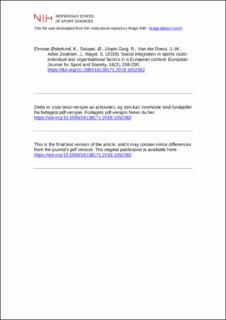| dc.contributor.author | Elmose-Østerlund, Karsten | |
| dc.contributor.author | Seippel, Ørnulf | |
| dc.contributor.author | Llopis-Goig, Ramon | |
| dc.contributor.author | Van der Roest, Jan-Willem | |
| dc.contributor.author | Adler Zwahlen, Jenny | |
| dc.contributor.author | Nagel, Siegfried | |
| dc.date.accessioned | 2021-02-09T14:09:33Z | |
| dc.date.available | 2021-02-09T14:09:33Z | |
| dc.date.created | 2019-10-28T15:03:18Z | |
| dc.date.issued | 2019 | |
| dc.identifier.citation | European Journal for Sport and Society (EJSS). 2019, 16(3), 268-290. | en_US |
| dc.identifier.issn | 1613-8171 | |
| dc.identifier.uri | https://hdl.handle.net/11250/2726956 | |
| dc.description | I Brage finner du siste tekst-versjon av artikkelen, og den kan inneholde ubetydelige forskjeller fra forlagets pdf-versjon. Forlagets pdf-versjon finner du på tandfonline.com / In Brage you'll find the final text version of the article, and it may contain insignificant differences from the journal's pdf version. The definitive version is available at tandfonline.com | en_US |
| dc.description.abstract | Sports clubs are often perceived as important mediums for social integration, but the empirical evidence to support this claim is limited. This article sets out to identify individual and organisational characteristics that are conducive to social integration of members and volunteers. Drawing on survey data from 13,000 members and volunteers in ten European countries, an exploratory factor analysis identified three dimensions of social integration. They match the overall conceptual distinction between socio-cultural and socio-affective integration and the sub-division of socio-affective integration into ‘interaction’ and ‘identification’. Multilevel regression analyses examined the relevance of individual-level variables (social background, club affiliation and participation as well as practiced sports activities) and organisational-level variables (management and structural characteristics) for the three dimensions of social integration. Empirical analyses revealed that the individual-level variables, especially affiliation and participation in the sports club (e.g. the number of years connected to the club, the frequency of sports and competition participation, the team/group size as well as volunteering), had explanatory power, while the organisational-level variables (management and structural characteristics) mainly showed weak correlations. With little variation at the country level and relatively consistent results across the three dimensions of social integration, the results indicate that it is mainly the same individual and organisational characteristics that are conducive to social integration in sports clubs. | en_US |
| dc.language.iso | eng | en_US |
| dc.subject | social integration | en_US |
| dc.subject | sports clubs | en_US |
| dc.subject | socio-cultural integration | en_US |
| dc.subject | socio-affective integration | en_US |
| dc.subject | club members | en_US |
| dc.title | Social integration in sports clubs: individual and organisational factors in a European context | en_US |
| dc.type | Peer reviewed | en_US |
| dc.type | Journal article | en_US |
| dc.description.version | acceptedVersion | en_US |
| dc.source.pagenumber | 23 | en_US |
| dc.source.journal | European Journal for Sport and Society (EJSS) | en_US |
| dc.identifier.doi | 10.1080/16138171.2019.1652382 | |
| dc.identifier.cristin | 1741292 | |
| dc.description.localcode | Institutt for idrett og samfunnsvitenskap / Department of Sport and Social Sciences | en_US |
| cristin.ispublished | true | |
| cristin.fulltext | postprint | |
| cristin.qualitycode | 1 | |
